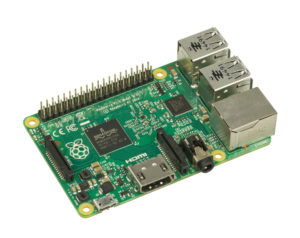Raspberry PI: credit-card sized computing

The Raspberry PI is a credit card-sized computer boasting low-power consumption and great capabilities. With its simplicity and low price it has created a new type of “computers” and accelerated the Internet of Things.
What is a Raspberry PI?
This is probably the first question we need to answer in order to get a better understanding of our little friend. Simply put: the Raspberry PI is a computer, a very small one in fact. It can do almost everything a modern computer can, but don’t start dreaming. The PI isn’t really powerful and it has never been its focus. The real purpose the PI was invented to fulfill is education. The original PI was designed to offer a low-power and low-cost platform that could run a modern operating system to teach children computer programming. The PI lived up to the expectations but it also evolved to be much more.
What can a Raspberry PI do?
Although not each model has the same set of specifications, you can expect them to behave alike. Every PI runs with low-power micro-usb power supplies. Almost all of them have HDMI, RCA and 3.5 Jack connectors that enable users to connect the Pi to external monitor (even old ones) and speakers. The most exciting feature however is probably the GPIO pins that enable programmers to communicate with other electronic devices such as lights, leds, valves etc. On the top of that it can run Linux, as a matter of fact GNU/Linux is the most used operating system on the PI. To run any operating system on the PI you will need a SD/MicroSD (depending on the model). There are many operating systems available like:
- Raspbian (Debian)
- Pidora (Fedora)
- OSMC (Raspbian+Kodi)
- Ubuntu Mate
- Windows IoT (not Linux, but still valuable)
As you can see there are many, and many more, some updated, some not. To get a glance head over to the official downloads page.
Open hardware
The Raspberry PI is an incredible product developed by the Raspberry PI foundation in the United Kingdom. One of the interesting things about the project is that it doesn’t only embrace Open Source but it takes it to the next step: Open Hardware. Open hardware means that you can take a look at the projects and schemas used to realize the Raspberry PI. This has created the possibility for others to create similar products like the Banana PI.
Raspberry and Arduino
One of the most common question is: “Should I buy a Raspberry or an Arduino?”. Well that’s like asking: cars or motorcycles? The answer is: it depends. The Raspberry Pi has more features, it runs an entire operating system whilst Arduino does not (except for some models). However, that doesn’t directly translates to “Raspberry is better than Arduino”. Arduino excels in analogical applications and its programming resembles PLC programming whilst Raspberry takes a “higher-level” approach. Many times, projects employ both Arduino and Pi rather than choosing one or the other.
Raspberry PI models
Up to this article there are seven different models available on the market:
- Pi 1 Family:
The entire first family shares the ARMv6 architecture and the Broadcom BCM2835 SoC. They also all have hdmi and rca output. And every model has a Broadcom VideoCore IV GPU with memory shared between CPU and GPU; and a audio jack output.- Model A: The lower-spec model with 256MB of RAM, 1 USB port, SD card slot and 26 GPIO pins. It has been superseded by Model A+.
- Model A+: The final review of model A. It has 512MB of RAM, 1 USB port, MicroSD card slot and 40 GPIO Pins.
- Model B: The higher-spec model with 512MB of RAM, 2 USB Ports, 1 Ethernet Port, SD card slot and 26 GPIO pins. It has been superseded by Model B+.
- Model B+: The final review of Model B. It has 512MB of RAM, 4 USB Ports, 1 Ethernet, MicroSD card slot and 40 GPIO pins. This model also boasted lower consumption compared to its predecessor. It has been superseded by Pi 2 Model B.
- Pi 2 Model B: The Pi 2 was a huge step forward. The SoC had been replaced with Broadcom BCM2836 thus the architecture switched to ARMv7 and the ram was bumped to 1GB. The Pi 2 switched to a quad-core cpu and could even run Windows IoT. The SD card has been entirely ditched in favour of Micro SD.
- Pi 3 Model B: The Pi 3 is the new kid in town, it uses the Broadcom BCM2837 with ARMv8 architecture (switching to 64bit). It also features on-board wi-fi (802.11n) and Bluetooth 4 and Bluetooth Low Energy.
- Pi Zero: is a relatively new model that features the same specs of Model A+ but with half the size. The GPIO interfaces don’t have pins, instead they are “unpopulated headers”. It also has 1 Micro-USB port and 1 Micro-HDMI port in stead of their larger variants.
- 2020 A year in review for Marksei.com - 30 December 2020
- Red Hat pulls the kill switch on CentOS - 16 December 2020
- OpenZFS 2.0 released: unified ZFS for Linux and BSD - 9 December 2020










Recent Comments